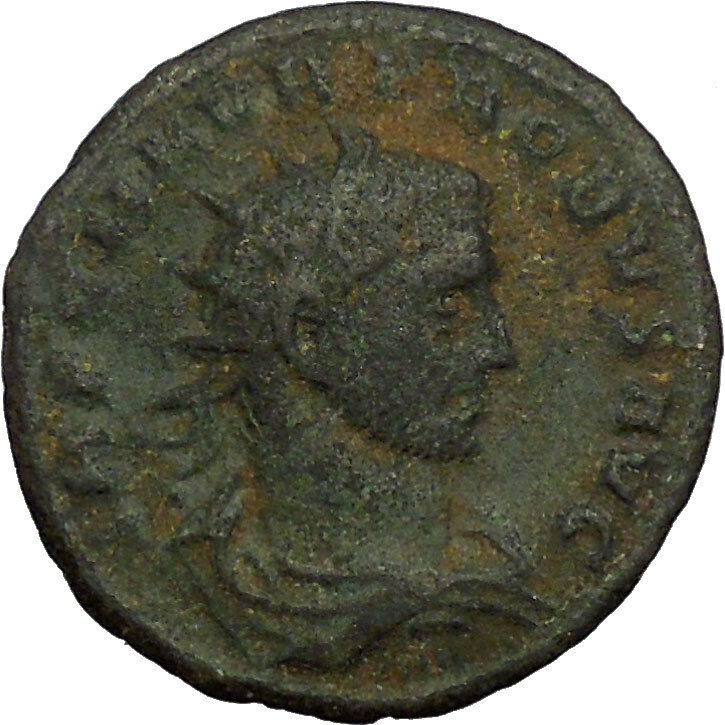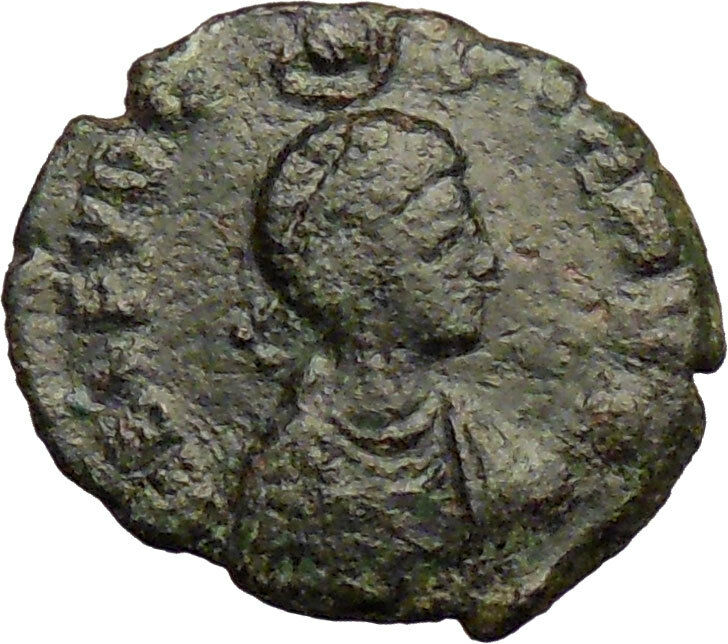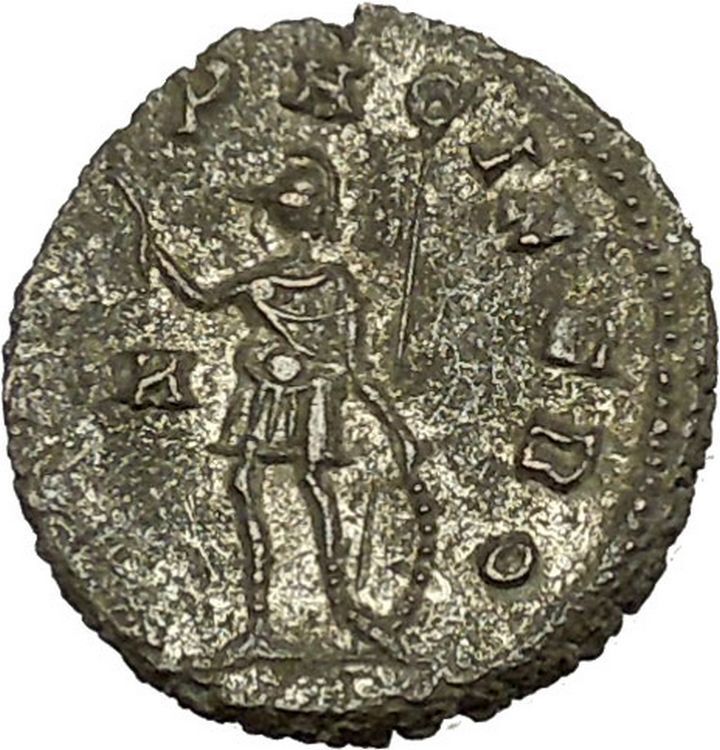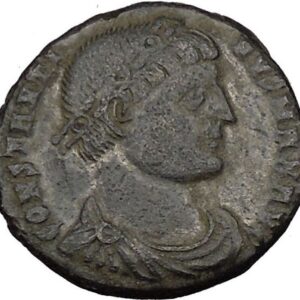|
Constantine I ‘The Great’
–
Roman Emperor
: 307-337 A.D. –
Bronze AE3 19mm (3.26 grams) Ticinum mint, circa 320-321 A.D.
Reference: RIC 140 (VII, Ticinum)
CONSTANTINVSAVG – Laureate head right.
DNCONSTANTINIMAXAVG Exe: ST – Wreath, VOT/XX within.
You are bidding on the exact item pictured,
provided with a Certificate of Authenticity and Lifetime Guarantee of
Authenticity.
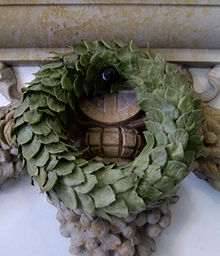
The
wreath was a symbol of victory in ancient Greek and Roman times, and references
to it are still used in modern English language, as some may term it to be a
“victory wreath.” A laurel wreath
,
oak wreath or wreath is a circular
wreath
made of interlocking branches and leaves
of the
bay laurel
(as in laurel wreath) (Laurus
nobilis, Lauraceae
), an aromatic broadleaf evergreen; or
branches and leaves of other plants. In
Greek mythology
,
Apollo
is represented wearing a laurel wreath
on his head. A wreath made of oak has connections to Jupiter, the Roman
equivalent of Zeus, as his sacred tree was the oak. In
ancient Greece
wreaths were awarded to victors,
both in athletic competitions, including the ancient
Olympics
made of wild olive-tree known as “kotinos“
(κότινος), (sc. at
Olympia
) and in poetic meets; in
Rome
they were symbols of martial victory,
crowning a successful commander during his
triumph
.
The wreath symbol was used often on ancient Greek and Roman coins. The wreath
on ancient Roman coins is often depicted being held by Jupiter’s (Zeus’) sacred
bird, the eagle, and also Victory (Nike) and by other deities less often; and
many coins with emperors depicted wearing it; and at times, entire designs being
surrounded by a wreath.
In common modern idiomatic
usage it refers to a victory. The
expression “resting on one’s laurels” refers to someone relying entirely on
long-past successes for continued fame or recognition, where to “look to one’s
laurels” encourages an individual to take inspiration from past achievements to
conquer a fresh task.
Constantine the Great (Latin:
Flavius Valerius Aurelius Constantinus Augustus;
27 February c. 272 – 22 May 337), also known as Constantine I or Saint
Constantine, was
Roman Emperor
from 306 to 337. Well known for
being the first Roman emperor to
be converted
to
Christianity
, Constantine and co-Emperor
Licinius
issued the
Edict of Milan
in 313, which proclaimed
tolerance of all religions
throughout the
empire.
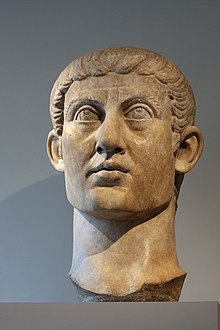
Constantine defeated the emperors
Maxentius
and
Licinius
during civil wars. He also fought
successfully against the
Franks
,
Alamanni
,
Visigoths
, and
Sarmatians
during his reign — even resettling
parts of Dacia
which had been abandoned during the
previous century. Constantine built a new imperial residence at
Byzantium
, naming it
New Rome
. However, in Constantine’s honor,
people called it
Constantinople
, which would later be the
capital of what is now known as the
Byzantine Empire
for over one thousand years.
Because of this, he is thought of as the founder of the Byzantine Empire.
Flavius Valerius Constantinus, as he was originally named, was born in the
city of Naissus,
Dardania
province of
Moesia
, in present-day
Niš,
Serbia
, on 27 February of an uncertain year,
probably near 272.
His father was
Flavius Constantius
, a native of
Dardania
province of Moesia (later
Dacia Ripensis
). Constantius was a tolerant and
politically skilled man. Constantine probably spent little time with his father.
Constantius was an officer in the Roman army, part of the Emperor
Aurelian
‘s imperial bodyguard. Constantius
advanced through the ranks, earning the
governorship
of
Dalmatia
from Emperor
Diocletian
, another of Aurelian’s companions
from
Illyricum
, in 284 or 285.Constantine’s mother
was
Helena
, a
Bithynian
woman of low social standing.It is
uncertain whether she was legally married to Constantius or merely his
concubine.
Helena gave birth to the future emperor
Constantine I
on 27 February of an uncertain
year soon after 270 (probably around 272). At the time, she was in
Naissus
(Niš,
Serbia
). In order to obtain a wife more
consonant with his rising status, Constantius divorced Helena some time before
289, when he married
Theodora
, Maximian’s daughter.(The narrative
sources date the marriage to 293, but the
Latin panegyric
of 289 refers to the couple as
already married). Helena and her son were dispatched to the court of
Diocletian
at Nicomedia, where Constantine grew
to be a member of the inner circle. Helena never remarried and lived for a time
in obscurity, though close to her only son, who had a deep regard and affection
for her.


She received the title of
Augusta
in 325 and died in 330 with her son
at her side. She was buried in the
Mausoleum of Helena
, outside
Rome on the
Via Labicana
. Her
sarcophagus
is on display in the
Pio-Clementine Vatican Museum
, although the
connection is often questioned, next to her is the sarcophagus of her
granddaughter Saint Constantina (Saint Constance). The elaborate reliefs contain
hunting scenes. During her life, she gave many presents to the poor, released
prisoners and mingled with the ordinary worshippers in modest attire.
Constantine received a formal education at Diocletian’s court, where he
learned Latin literature, Greek, and philosophy.
On 1 May 305, Diocletian, as a result of a debilitating sickness taken in the
winter of 304–5, announced his resignation. In a parallel ceremony in Milan,
Maximian did the same. Lactantius states that Galerius manipulated the weakened
Diocletian into resigning, and forced him to accept Galerius’ allies in the
imperial succession. According to Lactantius, the crowd listening to
Diocletian’s resignation speech believed, until the very last moment, that
Diocletian would choose Constantine and
Maxentius
(Maximian’s son) as his successors.
It was not to be: Constantius and Galerius were promoted to Augusti, while
Severus
and
Maximin
were appointed their Caesars
respectively. Constantine and Maxentius were ignored.
Constantine recognized the implicit danger in remaining at Galerius’ court,
where he was held as a virtual hostage. His career depended on being rescued by
his father in the west. Constantius was quick to intervene. In the late spring
or early summer of 305, Constantius requested leave for his son, to help him
campaign in Britain. After a long evening of drinking, Galerius granted the
request. Constantine’s later propaganda describes how he fled the court in the
night, before Galerius could change his mind. He rode from
post-house
to post-house at high speed,
hamstringing
every horse in his wake.By the
time Galerius awoke the following morning, Constantine had fled too far to be
caught. Constantine joined his father in
Gaul
, at Bononia (Boulogne)
before the summer of 305.
From Bononia they crossed the
Channel
to Britain and made their way to
Eboracum
(York),
capital of the province of
Britannia Secunda
and home to a large military
base. Constantine was able to spend a year in northern Britain at his father’s
side, campaigning against the
Picts
beyond
Hadrian’s Wall
in the summer and autumn.
Constantius’s campaign, like that of
Septimius Severus
before it, probably advanced
far into the north without achieving great success. Constantius had become
severely sick over the course of his reign, and died on 25 July 306 in
Eboracum
(York).
Before dying, he declared his support for raising Constantine to the rank of
full Augustus. The
Alamannic
king
Chrocus
, a barbarian taken into service under
Constantius, then proclaimed Constantine as Augustus. The troops loyal to
Constantius’ memory followed him in acclamation. Gaul and Britain quickly
accepted his rule; Iberia, which had been in his father’s domain for less than a
year, rejected it.
Constantine sent Galerius an official notice of Constantius’s death and his
own acclamation. Along with the notice, he included a portrait of himself in the
robes of an Augustus. The portrait was wreathed in
bay
. He requested recognition as heir to his
father’s throne, and passed off responsibility for his unlawful ascension on his
army, claiming they had “forced it upon him”.Galerius was put into a fury by the
message; he almost set the portrait on fire. His advisers calmed him, and argued
that outright denial of Constantine’s claims would mean certain war.Galerius was
compelled to compromise: he granted Constantine the title “Caesar” rather than
“Augustus” (the latter office went to Severus instead). Wishing to make it clear
that he alone gave Constantine legitimacy, Galerius personally sent Constantine
the emperor’s traditional
purple robes
. Constantine accepted the
decision. Constantine’s share of the Empire consisted of Britain, Gaul, and
Spain.
Because Constantine was still largely untried and had a hint of illegitimacy
about him, he relied on his father’s reputation in his early propaganda: the
earliest panegyrics to Constantine give as much coverage to his father’s deeds
as to those of Constantine himself.
Constantine’s military skill and building projects soon gave
the panegyrist the opportunity to comment favorably on the similarities between
father and son, and Eusebius remarked that Constantine was a “renewal, as it
were, in his own person, of his father’s life and reign”. Constantinian coinage,
sculpture and oratory also shows a new tendency for disdain towards the
“barbarians” beyond the frontiers. After Constantine’s victory over the Alemanni,
he minted a coin issue depicting weeping and begging Alemannic tribesmen—”The
Alemanni conquered”—beneath the phrase “Romans’ rejoicing”.There was little
sympathy for these enemies. As his panegyrist declared: “It is a stupid clemency
that spares the conquered foe.”

In 310, a dispossessed and power-hungry Maximian rebelled against Constantine
while Constantine was away campaigning against the Franks. Maximian had been
sent south to Arles with a contingent of Constantine’s army, in preparation for
any attacks by Maxentius in southern Gaul. He announced that Constantine was
dead, and took up the imperial purple. In spite of a large donative pledge to
any who would support him as emperor, most of Constantine’s army remained loyal
to their emperor, and Maximian was soon compelled to leave. Constantine soon
heard of the rebellion, abandoned his campaign against the Franks, and marched
his army up the Rhine. At Cabillunum (Chalon-sur-Saône),
he moved his troops onto waiting boats to row down the slow waters of the
Saône
to the quicker waters of the
Rhone
. He disembarked at
Lugdunum
(Lyon).Maximian
fled to Massilia (Marseille),
a town better able to withstand a long siege than Arles. It made little
difference, however, as loyal citizens opened the rear gates to Constantine.
Maximian was captured and reproved for his crimes. Constantine granted some
clemency, but strongly encouraged his suicide. In July 310, Maximian hanged
himself.
The death of Maximian required a shift in Constantine’s public image. He
could no longer rely on his connection to the elder emperor Maximian, and needed
a new source of legitimacy.In a speech delivered in Gaul on 25 July 310, the
anonymous orator reveals a previously unknown dynastic connection to
Claudius II
, a third-century emperor famed for
defeating the Goths and restoring order to the empire. Breaking away from
tetrarchic models, the speech emphasizes Constantine’s ancestral prerogative to
rule, rather than principles of imperial equality. The new ideology expressed in
the speech made Galerius and Maximian irrelevant to Constantine’s right to rule.
Indeed, the orator emphasizes ancestry to the exclusion of all other factors:
“No chance agreement of men, nor some unexpected consequence of favor, made you
emperor,” the orator declares to Constantine.
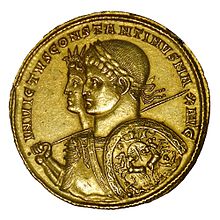
A gold multiple of “Unconquered Constantine” with
Sol
Invictus, struck in 313. The use of Sol’s image appealed to both the
educated citizens of Gaul, who would recognize
in it Apollo’s patronage of
Augustus
and the arts; and to Christians, who found solar monotheism less
objectionable than the traditional pagan pantheon.
The oration also moves away from the religious ideology of the Tetrarchy,
with its focus on twin dynasties of
Jupiter
and
Hercules
. Instead, the orator proclaims that
Constantine experienced a divine vision of
Apollo
and
Victory
granting him
laurel wreaths
of health and a long reign. In
the likeness of Apollo Constantine recognized himself as the saving figure to
whom would be granted “rule of the whole world”, as the poet Virgil had once
foretold. The oration’s religious shift is paralleled by a similar shift in
Constantine’s coinage. In his early reign, the coinage of Constantine advertised
Mars
as his patron. From 310 on, Mars was
replaced by
Sol Invictus
, a god conventionally identified
with Apollo.
By the middle of 310, Galerius had become too ill to involve himself in
imperial politics. His final act survives: a letter to the provincials posted in
Nicomedia on 30 April 311, proclaiming an end to the persecutions, and the
resumption of religious toleration. He died soon after the edict’s proclamation,
destroying what little remained of the tetrarchy. Maximin mobilized against
Licinius, and seized Asia Minor. A hasty peace was signed on a boat in the
middle of the Bosphorus. While Constantine toured Britain and Gaul, Maxentius
prepared for war.He fortified northern Italy, and strengthened his support in
the Christian community by allowing it to elect a new
Bishop
of
Rome
,
Eusebius
.
Constantine’s advisers and generals cautioned against preemptive attack on
Maxentius; even his soothsayers recommended against it, stating that the
sacrifices had produced unfavorable omens. Constantine, with a spirit that left
a deep impression on his followers, inspiring some to believe that he had some
form of supernatural guidance, ignored all these cautions. Early in the spring
of 312,Constantine crossed the
Cottian Alps
with a quarter of his army, a
force numbering about 40,000.The first town his army encountered was Segusium (Susa,
Italy
), a heavily fortified town that shut its
gates to him. Constantine ordered his men to set fire to its gates and scale its
walls. He took the town quickly. Constantine ordered his troops not to loot the
town, and advanced with them into northern Italy.
At the approach to the west of the important city of Augusta Taurinorum (Turin,
Italy), Constantine met a large force of heavily armed Maxentian cavalry. In the
ensuing
battle
Constantine’s army encircled Maxentius’
cavalry, flanked them with his own cavalry, and dismounted them with blows from
his soldiers’ iron-tipped clubs. Constantine’s armies emerged victorious. Turin
refused to give refuge to Maxentius’ retreating forces, opening its gates to
Constantine instead.
Other cities of the north Italian plain sent Constantine
embassies of congratulation for his victory. He moved on to Milan, where he was
met with open gates and jubilant rejoicing. Constantine rested his army in Milan
until mid-summer 312, when he moved on to
Brixia
(Brescia).
Brescia’s army was easily dispersed, and Constantine quickly advanced to
Verona
, where a large Maxentian force was
camped. Ruricius Pompeianus, general of the Veronese forces and Maxentius’
praetorian prefect, was in a strong defensive position, since the town was
surrounded on three sides by the
Adige
. Constantine sent a small force north of
the town in an attempt to cross the river unnoticed. Ruricius sent a large
detachment to counter Constantine’s expeditionary force, but was defeated.
Constantine’s forces successfully surrounded the town and laid siege. Ruricius
gave Constantine the slip and returned with a larger force to oppose
Constantine. Constantine refused to let up on the siege, and sent only a small
force to oppose him. In the desperately fought
encounter
that followed, Ruricius was killed
and his army destroyed.Verona surrendered soon afterwards, followed by
Aquileia
, Mutina (Modena),
and
Ravenna
. The road to Rome was now wide open to
Constantine.
Maxentius prepared for the same type of war he had waged against Severus and
Galerius: he sat in Rome and prepared for a siege. He still controlled Rome’s
praetorian guards, was well-stocked with African grain, and was surrounded on
all sides by the seemingly impregnable
Aurelian Walls
. He ordered all bridges across
the Tiber
cut, reportedly on the counsel of the
gods, and left the rest of central Italy undefended; Constantine secured that
region’s support without challenge. Constantine progressed slowly along the
Via Flaminia
, allowing the weakness of
Maxentius to draw his regime further into turmoil. Maxentius’ support continued
to weaken: at chariot races on 27 October, the crowd openly taunted Maxentius,
shouting that Constantine was invincible. Maxentius, no longer certain that he
would emerge from a siege victorious, built a temporary boat bridge across the
Tiber in preparation for a field battle against Constantine. On 28 October 312,
the sixth anniversary of his reign, he approached the keepers of the
Sibylline Books
for guidance. The keepers
prophesied that, on that very day, “the enemy of the Romans” would die.
Maxentius advanced north to meet Constantine in battle.
Maxentius organized his forces—still twice the size of Constantine’s—in long
lines facing the battle plain, with their backs to the river. Constantine’s army
arrived at the field bearing unfamiliar symbols on either its standards or its
soldiers’ shields. Constantine was visited by a dream the night before the
battle, wherein he was advised “to mark the heavenly sign of God on the shields
of his soldiers…by means of a slanted letter X with the top of its head bent
round, he marked Christ on their shields.” Eusebius describes the sign as
Chi
(Χ) traversed by
Rho
(Ρ): ☧, a symbol representing the first two
letters of the Greek spelling of the word Christos or Christ.
Constantine deployed his own forces along the whole length of Maxentius’
line. He ordered his cavalry to charge, and they broke Maxentius’ cavalry. He
then sent his infantry against Maxentius’ infantry, pushing many into the Tiber
where they were slaughtered and drowned. The battle was brief: Maxentius’ troops
were broken before the first charge. Maxentius’ horse guards and praetorians
initially held their position, but broke under the force of a Constantinian
cavalry charge; they also broke ranks and fled to the river. Maxentius rode with
them, and attempted to cross the bridge of boats, but he was pushed by the mass
of his fleeing soldiers into the Tiber, and drowned.
In Rome
Constantine entered Rome on 29 October.He staged a grand
adventus
in the city, and was met with
popular jubilation. Maxentius’ body was fished out of the Tiber and decapitated.
His head was paraded through the streets for all to see. Unlike his
predecessors, Constantine neglected to make the trip to the
Capitoline Hill
and perform customary
sacrifices at the
Temple of Jupiter
. He did, however, choose to
honor the
Senatorial
Curia
with a visit, where he promised to
restore its ancestral privileges and give it a secure role in his reformed
government: there would be no revenge against Maxentius’ supporters.In response,
the Senate decreed him “title of the first name”, which meant his name would be
listed first in all official documents, and acclaimed him as “the greatest
Augustus”. He issued decrees returning property lost under Maxentius, recalling
political exiles, and releasing Maxentius’ imprisoned opponents.
In the following years, Constantine gradually consolidated his military
superiority over his rivals in the crumbling Tetrarchy. In 313, he met
Licinius
in
Milan
to secure their alliance by the marriage
of Licinius and Constantine’s half-sister
Constantia
. During this meeting, the emperors
agreed on the so-called
Edict of Milan
,officially granting full
tolerance to Christianity and all religions in the Empire.The document had
special benefits for Christians, legalizing their religion and granting them
restoration for all property seized during Diocletian’s persecution.
In the year 320,
Licinius
reneged on the religious freedom
promised by the
Edict of Milan
in 313 and began to oppress
Christians anew, generally without bloodshed, but resorting to confiscations and
sacking of Christian office-holders.That became a challenge to Constantine in
the West, climaxing in the great civil war of 324. Licinius, aided by
Goth
mercenaries
, represented the past and the
ancient Pagan
faiths. Constantine and his
Franks
marched under the standard of the
labarum
, and both sides saw the battle in
religious terms. Outnumbered, but fired by their zeal, Constantine’s army
emerged victorious in the
Battle of Adrianople
. Licinius fled across the
Bosphorus and appointed
Martius Martinianus
, the commander of his
bodyguard, as Caesar, but Constantine next won the
Battle of the Hellespont
, and finally the
Battle of Chrysopolis
on 18 September
324.Licinius and Martinianus surrendered to Constantine at Nicomedia on the
promise their lives would be spared: they were sent to live as private citizens
in Thessalonica and Cappadocia respectively, but in 325 Constantine accused
Licinius of plotting against him and had them both arrested and hanged;
Licinius’s son (the son of Constantine’s half-sister) was also killed. Thus
Constantine became the sole emperor of the Roman Empire.
Foundation of
Constantinople
Licinius’ defeat came to represent the defeat of a rival center of Pagan and
Greek-speaking political activity in the East, as opposed to the Christian and
Latin-speaking Rome, and it was proposed that a new Eastern capital should
represent the integration of the East into the Roman Empire as a whole, as a
center of learning, prosperity, and cultural preservation for the whole of the
Eastern Roman Empire
. Among the various
locations proposed for this alternative capital, Constantine appears to have
toyed earlier with
Serdica
(present-day
Sofia
), as he was reported saying that “Serdica
is my Rome“. Sirmium
and
Thessalonica
were also considered. Eventually,
however, Constantine decided to work on the Greek city of
Byzantium
, which offered the advantage of
having already been extensively rebuilt on Roman patterns of urbanism, during
the preceding century, by
Septimius Severus
and
Caracalla
, who had already acknowledged its
strategic importance. The city was then renamed Constantinopolis
(“Constantine’s City” or
Constantinople
in English), and issued special
commemorative coins in 330 to honor the event. The new city was protected by the
relics of the
True Cross
, the
Rod of Moses
and other holy
relics
, though a cameo now at the
Hermitage Museum
also represented Constantine
crowned by the tyche
of the new city. The figures of old gods
were either replaced or assimilated into a framework of
Christian symbolism
. Constantine built the new
Church of the Holy Apostles
on the site of a
temple to Aphrodite
. Generations later there was the
story that a
divine vision
led Constantine to this spot, and
an angel
no one else could see, led him on a
circuit of the new walls. The capital would often be compared to the ‘old’ Rome
as Nova Roma Constantinopolitana, the “New Rome of Constantinople”.
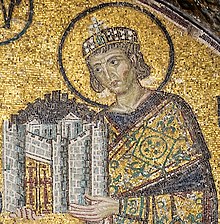
Constantine the Great, mosaic in
Hagia Sophia, c. 1000
Religious policy
Constantine is perhaps best known for being the first “Christian” Roman
emperor. Scholars debate whether Constantine adopted his mother
St. Helena
‘s
Christianity in his youth, or whether he adopted it gradually over the course of
his life.
Constantine was over 40 when he finally declared himself a Christian, writing to
Christians to make clear that he believed he owed his successes to the
protection of the Christian High God alone.Throughout his rule, Constantine
supported the Church financially, built basilicas, granted privileges to clergy
(e.g. exemption from certain taxes), promoted Christians to high office, and
returned property confiscated during the Diocletianic persecution.His most
famous building projects include the
Church of the Holy Sepulchre
, and
Old Saint Peter’s Basilica
.
However, Constantine certainly did not patronize Christianity alone. After
gaining victory in the Battle of the Milvian Bridge (312), a triumphal arch—the
Arch of Constantine
—was built (315) to
celebrate his triumph. The arch is most notably decorated with images of the
goddess
Victoria
and, at the time of its dedication,
sacrifices to gods like
Apollo
,
Diana
, and
Hercules
were made. Most notably absent from
the Arch are any depictions whatsoever regarding Christian symbolism.
Later in 321, Constantine instructed that Christians and non-Christians
should be united in observing the venerable day of the sun, referencing
the sun-worship
that
Aurelian
had established as an official cult.
Furthermore, and long after his oft alleged “conversion” to Christianity,
Constantine’s coinage continued to carry the symbols of the sun. Even after the
pagan gods had disappeared from the coinage, Christian symbols appeared only as
Constantine’s personal attributes: the
chi rho
between his hands or on his
labarum
, but never on the coin itself. Even
when Constantine dedicated the new capital of Constantinople, which became the
seat of Byzantine Christianity for a millennium, he did so wearing the
Apollonian
sun-rayed
Diadem
; no Christian symbols were present at
this dedication.
Constantine made new laws regarding the
Jews. They were forbidden to own Christian slaves or to
circumcise
their slaves.

Administrative reforms
Beginning in the mid-3rd century the emperors began to favor members of the
equestrian order
over senators, who had had a
monopoly on the most important offices of state. Senators were stripped of the
command of legions and most provincial governorships (as it was felt that they
lacked the specialized military upbringing needed in an age of acute defense
needs), such posts being given to equestrians by Diocletian and his
colleagues—following a practice enforced piecemeal by their predecessors. The
emperors however, still needed the talents and the help of the very rich, who
were relied on to maintain social order and cohesion by means of a web of
powerful influence and contacts at all levels. Exclusion of the old senatorial
aristocracy threatened this arrangement.
In 326, Constantine reversed this pro-equestrian trend, raising many
administrative positions to senatorial rank and thus opening these offices to
the old aristocracy, and at the same time elevating the rank of already existing
equestrians office-holders to senator, eventually wiping out the equestrian
order—at least as a bureaucratic rank—in the process. One could become a
senator, either by being elected
praetor
or (in most cases) by fulfilling a
function of senatorial rank: from then on, holding of actual power and social
status were melded together into a joint imperial hierarchy. At the same time,
Constantine gained with this the support of the old nobility, as the Senate was
allowed itself to elect praetors and
quaestors
, in place of the usual practice of
the emperors directly creating new magistrates (adlectio).
The Senate as a body remained devoid of any significant power; nevertheless,
the senators, who had been marginalized as potential holders of imperial
functions during the 3rd century, could now dispute such positions alongside
more upstart bureaucrats. Some modern historians see in those administrative
reforms an attempt by Constantine at reintegrating the senatorial order into the
imperial administrative elite to counter the possibility of alienating pagan
senators from a Christianized imperial rule.
Constantine’s reforms had to do only with the civilian administration: the
military chiefs, who since the
Crisis of the Third Century
had risen from the
ranks, remained outside the senate, in which they were included only by
Constantine’s children.

Monetary reforms
After the
runaway inflation of the third century
,
associated with the production of
fiat money
to pay for public expenses,
Diocletian had tried unsuccessfully to reestablish trustworthy minting of silver
and
billon
coins. The failure of the various
Diocletianic attempts at the restoration of a functioning silver coin resided in
the fact that the silver currency was overvalued in terms of its actual metal
content, and therefore could only circulate at much discounted rates. Minting of
the Diocletianic “pure” silver
argenteus
ceased, therefore, soon after
305, while the billon currency continued to be used until the 360s. From the
early 300s on, Constantine forsook any attempts at restoring the silver
currency, preferring instead to concentrate on minting large quantities of good
standard gold pieces—the
solidus
, 72 of which made a pound of gold. New
(and highly debased) silver pieces would continue to be issued during
Constantine’s later reign and after his death, in a continuous process of
retariffing, until this billon minting eventually ceased, de jure, in
367, with the silver piece being de facto continued by various
denominations of bronze coins, the most important being the
centenionalis
. Later emperors like
Julian the Apostate
tried to present themselves
as advocates of the humiles by insisting on trustworthy mintings of the
bronze currency.
Constantine’s monetary policy were closely associated with his religious
ones, in that increased minting was associated with measures of
confiscation—taken since 331 and closed in 336—of all gold, silver and bronze
statues from pagan temples, who were declared as imperial property and, as such,
as monetary assets. Two imperial commissioners for each province had the task of
getting hold of the statues and having them melded for immediate minting—with
the exception of a number of bronze statues who were used as public monuments
for the beautification of the new capital in Constantinople.
Later campaigns
Constantine considered Constantinople as his capital and permanent residence.
He lived there for a good portion of his later life. He rebuilt Trajan’s bridge
across the Danube, in hopes of reconquering
Dacia
, a province that had been abandoned under
Aurelian. In the late winter of 332, Constantine campaigned with the
Sarmatians
against the
Goths
. The weather and lack of food cost the
Goths dearly: reportedly, nearly one hundred thousand died before they submitted
to Rome. In 334, after Sarmatian commoners had overthrown their leaders,
Constantine led a campaign against the tribe. He won a victory in the war and
extended his control over the region, as remains of camps and fortifications in
the region indicate.Constantine resettled some Sarmatian exiles as farmers in
Illyrian and Roman districts, and conscripted the rest into the army.
Constantine took the title Dacicus maximus in 336.
Sickness and death
Constantine had known death would soon come. Within the Church of the Holy
Apostles, Constantine had secretly prepared a final resting-place for himself.It
came sooner than he had expected. Soon after the Feast of Easter 337,
Constantine fell seriously ill. He left Constantinople for the hot baths near
his mother’s city of Helenopolis (Altinova), on the southern shores of the Gulf
of İzmit. There, in a church his mother built in honor of Lucian the Apostle, he
prayed, and there he realized that he was dying. Seeking purification, he became
a catechumen
, and attempted a return to
Constantinople, making it only as far as a suburb of Nicomedia. He summoned the
bishops, and told them of his hope to be baptized in the
River Jordan
, where Christ was written to have
been baptized. He requested the baptism right away. The bishops, Eusebius
records, “performed the sacred ceremonies according to custom”. He chose the
Arianizing bishop
Eusebius of Nicomedia
, bishop of the
city
where he lay dying, as his baptizer. In
postponing his baptism, he followed one custom at the time which postponed
baptism until after infancy. Constantine died soon after at a suburban villa
called Achyron, on the last day of the fifty-day festival of Pentecost directly
following Pascha (or Easter), on 22 May 337.[246]
Following his death, his body was transferred to Constantinople and buried in
the
Church of the Holy Apostles
there. He was
succeeded by his three sons born of Fausta,
Constantine II
,
Constantius II
and
Constans
. A number of relatives were killed by
followers of Constantius, notably Constantine’s nephews
Dalmatius
(who held the rank of Caesar) and
Hannibalianus
, presumably to eliminate possible
contenders to an already complicated succession. He also had two daughters,
Constantina
and
Helena
, wife of
Emperor Julian
.
Legacy
The Byzantine Empire considered Constantine its founder and the
Holy Roman Empire
reckoned him among the
venerable figures of its tradition. In the later Byzantine state, it had become
a great honor for an emperor to be hailed as a “new Constantine”. Ten emperors,
including the last emperor of Byzantium, carried the name. Most Eastern
Christian churches consider Constantine a saint (Άγιος Κωνσταντίνος, Saint
Constantine). In the Byzantine Church he was called isapostolos (Ισαπόστολος
Κωνσταντίνος) —an
equal of the Apostles
.
Niš airport
is named Constantine the Great in
honor of his birth in Naissus.
The Roman Empire (Latin:
Imperium Romanum) was the post-Republican
period of the
ancient Roman civilization
, characterised by an
autocratic
form of government and large
territorial holdings in Europe and around the Mediterranean.

The Roman Empire at its greatest extent,
during the reign of Trajan
in 117 AD
The 500-year-old
Roman Republic
, which preceded it, had been
weakened and
subverted
through several
civil wars
. Several events are commonly
proposed to mark the transition from Republic to Empire, including
Julius Caesar
‘s appointment as perpetual
dictator
(44 BC), the
Battle of Actium
(2
September 31 BC), and the Roman Senate’s granting to
Octavian
the
honorific
Augustus
(16 January
27 BC).
Roman expansion began in the days of the Republic, but the Empire reached its
greatest extent under Emperor
Trajan
: during his reign (98 to 117 AD) the
Roman Empire controlled approximately 6.5 million km2
of land surface. Because of the Empire’s vast extent and long endurance, the
institutions and culture of Rome had a profound and lasting influence on the
development of language, religion, architecture, philosophy, law, and forms of
government in the territory it governed, particularly Europe, and by means of
European expansionism throughout the modern world.
In the late 3rd century AD,
Diocletian
established the practice of dividing
authority between four co-emperors (known as the
tetrarchy
) in order to better secure the vast
territory, putting an end to the
Crisis of the Third Century
. During the
following decades the Empire was often divided along an East/West axis. After
the death of
Theodosius I
in 395 it was divided for the last
time.
The
Western Roman Empire
collapsed
in 476 as
Romulus Augustus
was forced to abdicate to the
Germanic
warlord
Odoacer
. The Eastern Roman or
Byzantine Empire
ended in 1453 with the death
of
Constantine XI
and the
capture of Constantinople
to
Mehmed II
, leader of the
Ottoman Turks
.
Government
Emperor
The powers of an emperor (his
imperium
) existed, in theory at least, by
virtue of his “tribunician powers” (potestas tribunicia) and his
“proconsular powers” (imperium proconsulare). In theory, the tribunician
powers (which were similar to those of the
Plebeian Tribunes
under the old republic) made
the Emperor’s person and office sacrosanct, and gave the Emperor authority over
Rome’s civil government, including the power to preside over and to control the
Senate.
The proconsular powers (similar to those of military governors, or
Proconsuls
, under the old Republic) gave him
authority over the Roman army. He was also given powers that, under the
Republic, had been reserved for the
Senate
and the
assemblies
, including the right to declare war,
to ratify treaties, and to negotiate with foreign leaders.
The emperor also had the authority to carry out a range of duties that had
been performed by the
censors
, including the power to control Senate
membership. In addition, the emperor controlled the
religious institutions
, since, as emperor, he
was always
Pontifex Maximus
and a member of each of
the four major priesthoods. While these distinctions were clearly defined during
the early Empire, eventually they were lost, and the emperor’s powers became
less constitutional and more monarchical.
Realistically, the main support of an emperor’s power and authority was the
military. Being paid by the imperial treasury, the legionaries also swore an
annual military oath of loyalty towards him, called the
Sacramentum
.
The death of an emperor led to a crucial period of uncertainty and crisis. In
theory the Senate was entitled to choose the new emperor, but most emperors
chose their own successors, usually a close family member. The new emperor had
to seek a swift acknowledgement of his new status and authority in order to
stabilize the political landscape. No emperor could hope to survive, much less
to reign, without the allegiance and loyalty of the
Praetorian Guard
and of the legions. To secure
their loyalty, several emperors paid the
donativum
, a monetary reward.
Senate
While the
Roman assemblies
continued to meet after the
founding of the Empire, their powers were all transferred to the
Roman Senate
, and so senatorial decrees (senatus
consulta) acquired the full force of law.
In theory, the Emperor and the Senate were two equal branches of government,
but the actual authority of the Senate was negligible and it was largely a
vehicle through which the Emperor disguised his autocratic powers under a cloak
of republicanism. Although the Senate still commanded much prestige and respect,
it was largely a glorified
rubber stamp
institution. Stripped of most of
its powers, the Senate was largely at the Emperor’s mercy.
Many emperors showed a certain degree of respect towards this ancient
institution, while others were notorious for ridiculing it. During Senate
meetings, the Emperor sat between the two
consuls
,[18]
and usually acted as the presiding officer. Higher ranking senators spoke before
lower ranking senators, although the Emperor could speak at any time.[18]
By the 3rd century, the Senate had been reduced to a glorified municipal body.
Senators and
equestrians
No emperor could rule the Empire without the Senatorial order and the
Equestrian order
. Most of the more important
posts and offices of the government were reserved for the members of these two
aristocratic orders. It was from among their ranks that the provincial
governors, legion commanders, and similar officials were chosen.
These two classes were hereditary[citation
needed] and mostly closed to outsiders. Very
successful and favoured individuals could enter, but this was a rare occurrence.
The career of a young aristocrat was influenced by his family connections and
the favour of patrons. As important as ability, knowledge, skill, or competence,
patronage was considered vital for a successful career and the highest posts and
offices required the Emperor’s favour and trust.
Senatorial order
The son of a senator was expected to follow the
Cursus honorum
, a
career ladder
, and the more prestigious
positions were restricted to senators only. A senator also had to be wealthy;
one of the basic requirements was the wealth of 12,000 gold
aurei
(about 100 kg of gold), a figure which
would later be raised with the passing of centuries.
Equestrian order
Below the Senatorial order was the Equestrian order. The requirements and
posts reserved for this class, while perhaps not so prestigious, were still very
important. Some of the more vital posts, like the governorship of
Egypt
(Latin Aegyptus), were even
forbidden to the members of the Senatorial order and available only to
equestrians.
Military
Legions
During and after the civil war, Octavian reduced the huge number of the
legions
(over 60) to a much more manageable and
affordable size (28). Several legions, particularly those with doubtful
loyalties, were simply disbanded. Other legions were amalgamated, a fact
suggested by the title Gemina (Twin).
In AD 9, Germanic tribes wiped out three full legions in the
Battle of the Teutoburg Forest
. This disastrous
event reduced the number of the legions to 25. The total of the legions would
later be increased again and for the next 300 years always be a little above or
below 30.
Augustus also created the
Praetorian Guard
: nine
cohorts
ostensibly to maintain the public peace
which were garrisoned in Italy. Better paid than the legionaries, the
Praetorians also served less time; instead of serving the standard 25 years of
the legionaries, they retired after 16 years of service.
Auxilia
While the
auxilia
(Latin: auxilia = supports) are
not as famous as the legionaries, they were of major importance. Unlike the
legionaries, the auxilia were recruited from among the non-citizens. Organized
in smaller units of roughly cohort strength, they were paid less than the
legionaries, and after 25 years of service were rewarded with
Roman citizenship
, also extended to their sons.
According to Tacitus
there were roughly as many auxiliaries
as there were legionaries. Since at this time there were 25 legions of around
5,000 men each, the auxilia thus amounted to around 125,000 men, implying
approximately 250 auxiliary regiments.
Navy
The Roman navy
(Latin: Classis, lit.
“fleet”) not only aided in the supply and transport of the legions, but also
helped in the protection of the frontiers in the rivers
Rhine
and
Danube
. Another of its duties was the
protection of the very important maritime trade routes against the threat of
pirates. Therefore it patrolled the whole of the Mediterranean, parts of the
North Atlantic
(coasts of Hispania, Gaul, and
Britannia), and had also a naval presence in the
Black Sea
. Nevertheless the army was considered
the senior and more prestigious branch.
Provinces
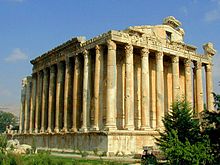
The
Temple of Bacchus
in
Baalbec
,
Lebanon
Until the Tetrarchy
(296 AD) Roman provinces (lat.
provincae) were administrative and territorial units of the Roman Empire
outside of
Italy
. In the old days of the Republic the
governorships of the provinces were traditionally awarded to members of the
Senatorial Order
. Augustus’ reforms changed
this policy.
Imperial provinces
Augustus created the
Imperial provinces
. Most, but not all, of the
Imperial provinces were relatively recent conquests and located at the borders.
Thereby the overwhelming majority of legions, which were stationed at the
frontiers, were under direct Imperial control. Very important was the
Imperial province of Egypt
, the major
breadbasket
of the Empire, whose
grain supply
was vital to feed the masses in
Rome. It was considered the personal fiefdom of the Emperor, and Senators were
forbidden to even visit this province. The governor of Egypt and the commanders
of any legion stationed there were not from the Senatorial Order, but were
chosen by the Emperor from among the members of the lower
Equestrian Order
.
Senatorial provinces
The old traditional policy continued largely unchanged in the
Senatorial provinces
. Due to their location,
away from the borders, and to the fact that they were under longer Roman
sovereignty and control, these provinces were largely peaceful and stable. Only
a single legion was based in a Senatorial province:
Legio III Augusta
, stationed in the Senatorial
province of
Africa
(modern northern Algeria).
The status of a province was subject to change; it could change from
Senatorial towards Imperial, or vice-versa. This happened several times
[26]
during Augustus’ reign. Another
trend was to create new provinces, mostly by dividing older ones, or by
expanding the Empire.
Religion

The
Pantheon
, the present structure
built during
Hadrian
‘s reign, was dedicated to
the worship of all Roman deities.
As the Empire expanded, and came to include people from a variety of
cultures, the worship of an ever increasing number of
deities
was tolerated and accepted. The
Imperial government, and the Romans in general, tended to be very tolerant
towards most religions and cults, so long as they did not cause trouble. This
could easily be accepted by other faiths as Roman liturgy and ceremonies were
frequently tailored to fit local culture and identity. Since the Romans
practiced polytheism they were also able to easily assimilate the gods of the
peoples the Empire conquered.
An individual could attend to both the Roman gods representing his Roman
identity and his own personal faith, which was considered part of his personal
identity. There were periodic persecutions of various religions at various
points in time, most notably that of Christians. As the historian
Edward Gibbon
noted, however, most of the
recorded histories of Christian persecutions come to us through the Christian
church, which had an incentive to exaggerate the degree to which the
persecutions occurred. The non-Christian contemporary sources only mention the
persecutions passingly and without assigning great importance to them.
Imperial cult

The
Augustus of Prima Porta
,
showing
Augustus
in military outfit holding
a consular baton (now broken off)
In an effort to enhance loyalty, the inhabitants of the Empire were called to
participate in the
Imperial cult
to revere (usually deceased)
emperors as demigods
. Few emperors claimed to be Gods while
living, with the few exceptions being emperors who were widely regarded at the
time to be insane (such as
Caligula
). Doing so in the early Empire would
have risked revealing the shallowness of what the Emperor
Augustus
called the “restored Republic” and
would have had a decidedly eastern quality to it. Since the tool was mostly one
the Emperor used to control his subjects, its usefulness would have been
greatest in the chaotic later Empire, when the emperors were often Christians
and unwilling to participate in the practice.
Usually, an emperor was deified after his death by his successor in an
attempt by that successor to enhance his own prestige. This practice can be
misunderstood, however, since “deification” was to the ancient world what
canonization is to the Christian world. Likewise, the term “god” had a different
context in the ancient world. This could be seen during the years of the
Roman Republic
with religio-political practices
such as the disbanding of a Senate session if it was believed the gods
disapproved of the session or wished a particular vote. Deification was one of
the many honors a dead emperor was entitled to, as the Romans (more than modern
societies) placed great prestige on honors and national recognitions.
The importance of the Imperial cult slowly grew, reaching its peak during the
Crisis of the Third Century
. Especially in the
eastern half of the Empire, imperial cults grew very popular. As such it was one
of the major agents of
romanization
. The central elements of the cult
complex were next to a temple; a
theatre
or
amphitheatre
for gladiator displays and other
games and a public bath complex
. Sometimes the imperial
cult was added to the cults of an existing temple or celebrated in a special
hall in the bath complex.
The seriousness of this belief is unclear. Some Romans ridiculed the notion
that a Roman emperor was to be considered a living god, or would even make fun
of the deification of an emperor after his death.
Seneca the Younger
parodied the notion of
apotheosis in his only known satire
The Pumpkinification of Claudius
, in which
the clumsy and ill-spoken
Claudius
is transformed not into a god, but a
pumpkin or gourd
. An element of mockery was present even
at Claudius’s funeral, and
Vespasian
‘s purported last words were Væ,
puto deus fio, “Oh dear! I think I’m becoming a god!”.
Absorption of
foreign cults
Since Roman religion did not have a core belief that excluded other
religions, several foreign gods and cults became popular.
The worship of Cybele
was the earliest, introduced from around
200 BC. Isis
and
Osiris
were introduced from Egypt a century
later. Bacchus
and
Sol Invictus
were quite important and
Mithras
became very popular with the military.
Several of these were
Mystery cults
. In the 1st century BC
Julius Caesar
granted Jews the freedom to
worship in Rome as a reward for their help in Alexandria.
Controversial
religions
Druids
Druids
were considered as essentially
non-Roman: a prescript of
Augustus
forbade Roman citizens to practice
“druidical” rites.
Pliny
reports that under
Tiberius
the druids were suppressed—along with
diviners and physicians—by a decree of the Senate, and
Claudius
forbade their rites completely in
AD 54.
Judaism
While Judaism was largely accepted, as long as Jews paid the
Jewish Tax
after 70 AD, there was
anti-Judaism in the pre-Christian Roman Empire
and there were several
Jewish-Roman wars
.
The Crisis under
Caligula
(37–41) has been proposed as the
“first open break between Rome and the Jews”, even though problems were already
evident during the
Census of Quirinius
in 6 and under
Sejanus
(before 31).
Until the rebellion in Judea in AD 66, Jews were generally protected. To get
around Roman laws banning secret societies and to allow their freedom of
worship, Julius Caesar declared Synagogues were colleges. Tiberius forbade
Judaism in Rome but they quickly returned to their former protected status.
Claudius expelled Jews from the city; however, the passage of Suetonius is
ambiguous: “Because the Jews at Rome caused continuous disturbances at the
instigation of Chrestus he [Claudius] expelled them from the city.” Chrestus
has been identified as another form of Christus; the disturbances may
have been related to the
arrival of the first Christians
, and that the
Roman authorities, failing to distinguish between the Jews and the early
Christians, simply decided to expel them all.
Historians debate whether or not the Roman government distinguished between
Christians and Jews
prior to Nerva’s
modification of the
Fiscus Judaicus
in 96. From then on, practising
Jews paid the tax; Christians did not.[34]
Christianity

The Christian Martyrs’ Last Prayer, by
Jean-Léon Gérôme
(1883). Roman
Colosseum
.
Christianity
emerged in
Roman Judea
as a
Jewish religious sect
in the 1st century AD.
The religion gradually spread out of
Jerusalem
, initially establishing major bases
in first Antioch
, then
Alexandria
, and over time throughout the Empire
as well as beyond.
Christianity shares numerous traits with other mystery cults that existed in
Rome at the time. Early Christianity placed a strong emphasis on baptism, a
ritual which marked the convert as having been inducted into the mysteries of
the faith. The focus on a belief in salvation and the afterlife was another
major similarity to other mystery cults. The crucial difference between
Christianity and other mystery cults was the
monotheism
of Christianity. Early Christians
thus refused to participate in civic cults because of these monotheistic
beliefs, leading to their persecution.
For the first two centuries of the
Christian era
, Imperial authorities largely
viewed Christianity simply as a Jewish sect rather than a distinct religion. No
emperor issued general laws against the faith or its Church, and persecutions,
such as they were, were carried out under the authority of local government
officials. A surviving letter from
Pliny the Younger
, governor of Bythinia, to the
Emperor Trajan
describes his persecution and executions
of Christians; Trajan notably responded that Pliny should not seek out
Christians nor heed anonymous denunciations, but only punish open Christians who
refused to recant.
Suetonius
mentions in passing that during the
reign of Nero
“punishment was inflicted on the
Christians, a class of men given to a new and mischievous
superstition
” (superstitionis novae ac
maleficae). He gives no reason for the punishment.
Tacitus
reports that after the
Great Fire of Rome
in AD 64, some among the
population held Nero responsible and that the emperor attempted to deflect blame
onto the Christians.
One of the earliest persecutions occurred in
Gaul at
Lyon in 177
. Persecution was often local and
sporadic, and some Christians welcomed
martyrdom as a testament of faith
.[39]
The
Decian persecution
(246–251) was a serious
threat to the Church, but while it potentially undermined the religious
hierarchy in urban centers, ultimately it served to strengthen Christian
defiance.[40]
Diocletian
undertook what was to be the
most severe and last major persecution of Christians
,
lasting from 303 to 311. Christianity had become too widespread to suppress, and
in 313, the
Edict of Milan
made tolerance the official
policy.
Constantine I
(sole ruler 324–337) became the
first Christian emperor, and in 380
Theodosius I
established Christianity as the
official religion.
By the 5th century Christian hegemony had rapidly changed the Empire’s
identity even as the Western provinces collapsed. Those who practiced the
traditional polytheistic religions were persecuted, as were Christians regarded
as heretics by the authorities in power.
Languages
The language of Rome before its expansion was
Latin
, and this became the empire’s official
language. By the time of the imperial period Latin had developed two
registers
: the “high” written
Classical Latin
and the “low” spoken
Vulgar Latin
. While Classical Latin remained
relatively stable, even through the
Middle Ages
, Vulgar Latin as with any spoken
language was fluid and evolving. Vulgar Latin became the
lingua franca
in the western provinces, later
evolving into the modern
Romance languages
:
Italian
,
French
,
Portuguese
,
Spanish
,
Romanian
, etc. Greek and Classical Latin were
the languages of literature, scholarship, and education.
Although Latin remained the most widely spoken language in the West, through
to the
fall of Rome
and for some centuries afterwards,
in the East the
Greek language
was the literary language and
the lingua franca. The Romans generally did not attempt to supplant local
languages. They generally left established customs in place and only gradually
introduced typical Roman cultural elements including the Latin language.[43]
Along with Greek, many other languages of different tribes were used but almost
without expression in writing.
Greek was already widely spoken in many cities in the east, and as such, the
Romans were quite content to retain it as an administrative language there
rather than impede bureaucratic efficiency. Hence, two official secretaries
served in the Roman Imperial court, one charged with correspondence in Latin and
the other with correspondence in Greek for the East.[44]
Thus in the Eastern Province, as with all provinces, original languages were
retained.
Moreover, the process of hellenisation widened its scope during the Roman
period, for the Romans perpetuated
“Hellenistic”
culture,[47][48][nb
4] but with all the trappings of
Roman
improvements. This further spreading of
“Hellenistic” culture (and therefore language) was largely due to the extensive
infrastructure (in the form of entertainment, health, and education amenities,
and extensive transportation networks, etc.) put in place by the Romans and
their tolerance of, and inclusion of, other cultures, a characteristic which set
them apart from the xenophobic nature of the Greeks preceding them.
Since the Roman annexation of Greece in 146 BC, the Greek language gradually
obtained a unique place in the Roman world, owing initially to the large number
of Greek slaves in Roman households. In Rome itself Greek became the second
language of the educated elite.It became the common language in the early
Church
(as its major centers in the early
Christian period were in the East), and the language of scholarship and the
arts.
However, due to the presence of other widely spoken languages in the densely
populated east, such as
Coptic
,
Syriac
,
Armenian
,
Aramaic
and
Phoenician
(which was also extensively spoken
in North Africa), Greek never took as strong a hold beyond Asia Minor (some
urban enclaves notwithstanding) as Latin eventually did in the west. This is
partly evident in the extent to which the derivative languages are spoken today.
Like Latin, the language gained a
dual nature
with the literary language, an
Attic Greek
variant, existing alongside spoken
language, Koine Greek
, which evolved into
Medieval
or Byzantine Greek (Romaic).
By the 4th century AD, Greek no longer held such dominance over Latin in the
arts and sciences as it had previously, resulting to a great extent from the
growth of the western provinces. This was true also of Christian literature,
reflected, for example, in the publication in the early 5th century AD of the
Vulgate Bible
, the first officially accepted
Latin Bible
. As the Western Empire
declined
, the number of people who spoke both
Greek and Latin declined as well, contributing greatly to the future
East
–West
/
Orthodox
–Catholic
cultural divide in Europe.
Important as both languages were, today the
descendants of Latin
are widely spoken in many
parts of the world, while the Greek dialects are limited mostly to Greece,
Cyprus
, and small enclaves in
Turkey
and
Southern Italy
(where the
Eastern Empire
retained control for several
more centuries). To some degree this can be attributed to the fact that the
western provinces fell mainly to “Latinised”
Christian
tribes whereas the eastern provinces
fell to Muslim Arabs and Turks for whom Greek held less cultural significance.
Culture
Life in the Roman Empire revolved around the city of Rome, and its famed
seven hills
. The city also had several
theatres
,
gymnasia
, and many
taverns
,
baths
and
brothels
. Throughout the territory under Rome’s
control, residential architecture ranged from very modest houses to
country villas
, and in the
capital city
of Rome, to the residences on the
elegant
Palatine Hill
, from which the word “palace”
is derived. The vast majority of the population lived in the city centre, packed
into apartment blocks.
Most Roman towns and cities had a
forum
and temples, as did the city of Rome
itself.
Aqueducts
were built to bring water to urban
centres[55]
and served as an avenue to import
wine
and
oil
from abroad. Landlords generally resided in
cities and their estates were left in the care of farm managers. To stimulate a
higher labour productivity, many landlords freed a large numbers of slaves. By
the time of Augustus, cultured Greek household slaves taught the Roman young
(sometimes even the girls). Greek sculptures adorned Hellenistic landscape
gardening on the Palatine or in the
villas
.
Many aspects of Roman culture were taken from the
Etruscans
and the
Greeks
. In
architecture
and
sculpture
, the difference between Greek models
and Roman paintings are apparent. The chief Roman contributions to architecture
were the arch
and the
dome.
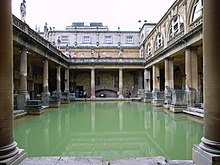
Roman public baths
(Thermae)
in
Bath
, England (Aquae
Sulis in the Roman province of
Britannia
).
The centre of the early social structure was the family, which was not only
marked by
blood relations
but also by the legally
constructed relation of patria potestas. The
Pater familias
was the absolute head of the
family; he was the master over his wife, his children, the wives of his sons,
the nephews, the slaves and the freedmen, disposing of them and of their goods
at will, even putting them to death. Originally, only patrician aristocracy
enjoyed the privilege of forming familial clans, or gens, as legal
entities; later, in the wake of political struggles and warfare, clients were
also enlisted. Thus, such plebian gentes were the first formed, imitating
their patrician counterparts.
Slavery
and slaves were part of the social
order; there were
slave markets
where they could be bought and
sold. Many slaves were freed by the masters for services rendered; some slaves
could save money to buy their freedom. Generally
mutilation
and murder of slaves was prohibited
by legislation. It is estimated that over 25% of the Roman population was
enslaved Professor
Gerhard Rempel
from the
Western New England College
claims that in the
city of Rome alone, during the Empire, there were about 400,000 slaves.
The city of Rome had a place called the
Campus Martius
(“Field of Mars”), which was a
sort of drill ground for Roman soldiers. Later, the Campus became Rome’s track
and field playground. In the campus, the youth assembled to play and exercise,
which included jumping,
wrestling
,
boxing
and
racing
.
Riding
, throwing, and swimming were also
preferred physical activities.
In the countryside, pastimes also included fishing and hunting.
Board games
played in Rome included
Dice (Tesserae or
Tali
), Roman Chess (Latrunculi),
Roman Checkers
(Calculi),
Tic-tac-toe
(Terni Lapilli), and
Ludus duodecim scriptorum
and Tabula,
predecessors of backgammon. There were several other activities to keep people
engaged like chariot races, musical and theatrical performances,
Clothing,
dining, and the arts

Fresco of a Roman woman from
Pompeii
, c. AD 50.
Roman clothing fashions changed little from the late Republic to the end of
the Western empire 600 years later. The cloth and the dress distinguished one
class of people from the other class. The tunic worn by
plebeians
(common people) like shepherds and
slaves was made from coarse and dark material, whereas the
tunic
worn by
patricians
was of linen or white wool. A
magistrate would wear the tunica augusticlavi; senators wore a tunic with
broad stripes, called tunica laticlavi. Military tunics were shorter than
the ones worn by civilians. Boys, up until the festival of Liberalia, wore the
toga praetexta, which was a toga with a crimson or purple border. The
toga virilis, (or toga pura) was worn by men over the age of 16 to
signify their citizenship in Rome.
The toga picta was worn by triumphant generals and had embroidery of
their skill on the battlefield. The toga pulla was worn when in mourning.
Even footwear indicated a person’s social status: patricians wore red and orange
sandals, senators had brown footwear, consuls had white shoes, and soldiers wore
heavy boots. Men typically wore a
toga, and women a
stola
. The woman’s stola looked
different from a toga, and was usually brightly coloured. The Romans also
invented
socks
for those soldiers required to fight on
the northern frontiers, sometimes worn in sandals.
In the later empire after
Diocletian
‘s reforms, clothing worn by soldiers
and non-military government bureaucrats became highly decorated, with woven or
embroidered strips, clavi, and circular roundels, orbiculi, added
to tunics and cloaks. These decorative elements usually consisted of geometrical
patterns and stylised plant motifs, but could include human or animal figures.
The use of silk also increased steadily and most courtiers of the later empire
wore elaborate silk robes. Heavy military-style belts were worn by bureaucrats
as well as soldiers, revealing the general militarization of late Roman
government. Trousers—considered barbarous garments worn by Germans and
Persians—were only adopted partially near the end of the empire in a sign for
conservatives of cultural decay. Early medieval kings and aristocrats dressed
like late Roman generals, not like the older toga-clad senatorial tradition.
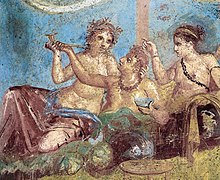
Roman fresco with banquet scene from the Casa dei Casti Amanti
(IX 12, 6-8) in Pompeii.
Romans had simple food habits. Staple food was simple, generally consumed at
around 11 o’clock, and consisted of bread, salad, cheese, fruits, nuts, and cold
meat left over from the dinner the night before. The Roman poet,
Horace
mentions another Roman favourite, the
olive
, in reference to his own diet, which he
describes as very simple: “As for me, olives,
endives
, and smooth
mallows
provide sustenance.” The family ate
together, sitting on stools around a table. Fingers were used to eat solid foods
and spoons were used for soups.
Wine was considered a staple drink, consumed at all meals and occasions by
all classes and was quite cheap. Many types of drinks involving grapes and honey
were consumed as well. Drinking on an empty stomach was regarded as boorish and
a sure sign for
alcoholism
, whose debilitating physical and
psychological effects were known to the Romans. An accurate accusation of being
an alcoholic was an effective way to discredit political rivals.
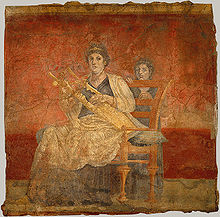
Woman playing a
kithara
, a wall mural from
Boscoreale
, dated 40–30 BC
Roman literature was from its very inception influenced heavily by Greek
authors. Some of the earliest works we possess are of historical epics telling
the early military history of Rome. As the empire expanded, authors began to
produce poetry, comedy, history, and tragedy.
Virgil
represents the pinnacle of Roman epic
poetry. His Aeneid
tells the story of flight of Aeneas
from Troy
and his settlement of the city that would
become Rome. The genre of satire was common in Rome, and satires were written
by, among others,
Juvenal
and
Persius
. Many Roman homes were decorated with
landscapes by Greek artists. Portrait sculpture during the period utilized
youthful and classical proportions, evolving later into a mixture of realism and
idealism. Advancements were also made in relief sculptures, often depicting
Roman victories.
Music was a major part of everyday life. The word itself derives from
Greek
μουσική (mousike), “(art)
of the
Muses
“. Many private and public events were
accompanied by music, ranging from nightly dining to military parades and
maneuvers. In a discussion of any ancient music, however, non-specialists and
even many musicians have to be reminded that much of what makes our modern music
familiar to us is the result of developments only within the last 1,000 years;
thus, our ideas of melody, scales, harmony, and even the instruments we use
would not be familiar to Romans who made and listened to music many centuries
earlier.
Over time, Roman architecture was modified as their urban requirements
changed, and the
civil engineering
and building
construction
technology
became developed and refined. The
Roman concrete
has remained a riddle, and even
after more than 2,000 years some Roman structures still stand magnificently.[76]
The architectural style of the capital city was emulated by other urban centres
under Roman control and influence.
Education
Following various military conquests in the
Greek East
, Romans adapted a number of Greek
educational precepts to their own system. Home was often the learning centre,
where children were taught
Roman law
,
customs
, and physical training to prepare the
boys for eventual recruitment into the
Roman army
. Conforming to discipline was a
point of great emphasis. Girls generally received instruction[78]
from their mothers in the art of
spinning
,
weaving
, and
sewing
.
Education nominally began at the age of six. During the next six to seven
years, both boys and girls were taught the basics of
reading
,
writing
and
arithmetic
. From the age of twelve, they would
be learning Latin
,
Greek
,
grammar
and
literature
, followed by training for
public speaking
.
Oratory
was an art to be practised and learnt,
and good orators commanded respect. To become an effective orator was one of the
objectives of education
and
learning
. In some cases, services of gifted
slaves were utilized for imparting education.
Economy
The invention and widespread application of
hydraulic mining
, namely
hushing
and ground-sluicing, aided by the
ability of the Romans to plan and execute mining operations on a large scale,
allowed various base and precious metals to be extracted on a proto-industrial
scale.
The annual total iron
output is estimated at 82,500 t,
assuming a productive capacity of c. 1.5 kg per capita.[81]
Copper
was produced at an annual rate of
15,000 t, and lead
at 80,000 t,[83]
both production levels not to be paralled until the
Industrial Revolution
;[84]
Spain alone had a 40% share in world lead production. The high lead output was a
by-product of extensive
silver
mining which reached an amount of 200 t
per annum.[86]
At its peak around the mid-2nd century AD, the Roman silver stock is estimated
at 10,000 t, five to ten times larger than the combined silver mass of
medieval Europe
and the
Caliphate
around 800 AD. Any one of the
Imperium’s most important mining provinces produced as much silver as the
contemporary
Han empire
as a whole, and more
gold by an entire order of magnitude.
The high amount of metal coinage in circulation meant that more coined money
was available for trading or saving in the economy (monetization).
Currency
The imperial government was, as all governments, interested in the issue and
control of the currency in circulation. To mint coins was an important political
act: the image of the ruling emperor appeared on most issues, and coins were a
means of showing his image throughout the empire. Also featured were
predecessors, empresses, other family members, and
heirs apparent
. By issuing coins with the image
of an heir his legitimacy and future succession was proclaimed and reinforced.
Political messages and imperial propaganda such as proclamations of victory and
acknowledgements of loyalty also appeared in certain issues.
Legally only the emperor and the Senate had the authority to mint coins
inside the empire. However the authority of the Senate was mainly in name only.
In general, the imperial government issued gold and silver coins while the
Senate issued bronze coins marked by the legend “SC”, short for
Senatus Consulto “by decree of the Senate”. However, bronze coinage could be
struck without this legend. Some Greek cities were allowed to mint[91]
bronze and certain silver coins, which today are known as Greek Imperials
(also Roman Colonials or Roman Provincials). The imperial mints
were under the control of a chief financial minister, and the provincial mints
were under the control of the imperial provincial procurators. The Senatorial
mints were governed by officials of the Senatorial treasury.
|























